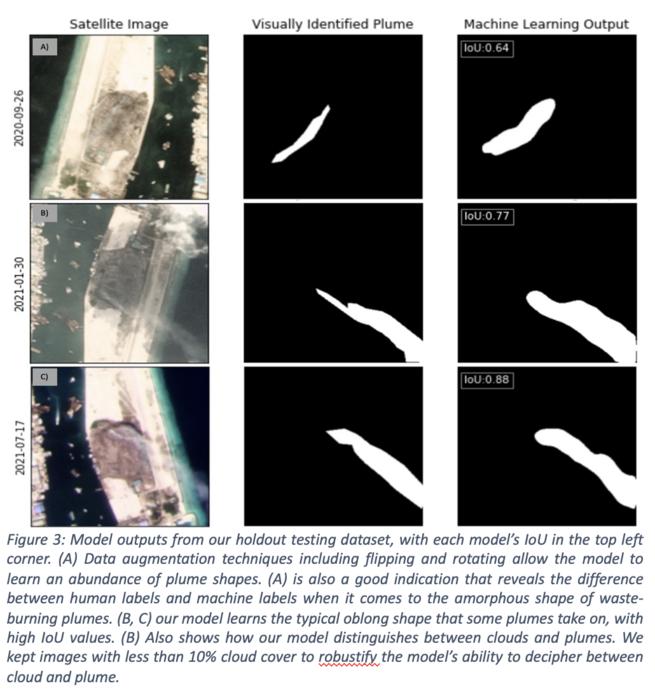DURHAM, N.C. – White sand beaches. Crystalline waters. Toxic smoke plumes wafting across a paradise clogged with plastic trash.

Credit: Creative Commons by Ibrahim Asad
DURHAM, N.C. – White sand beaches. Crystalline waters. Toxic smoke plumes wafting across a paradise clogged with plastic trash.
That was the Republic of Maldives in early 2021, which prompted its government to ban open trash burning and single-use plastics later that year. But until recently, uncertainty remained as to whether or not the government actually put its money where its mouth was and enforced the policy changes.
New research from Duke University which used advanced AI techniques to analyze satellite images of the nation of islands in the middle of the Indian Ocean has demonstrated that the government’s ban on open burning has indeed effectively stamped out the smoke plumes.
This approach has the potential to spot similar plumes generated by wildfires, power plants, or industrial facilities. The findings were published on July 7th in Environmental Science & Technology Letters.
The Maldives is made of 1200 islands. Its largest, Male, is one of the most densely populated places on earth, generating hundreds of tons of waste every day. A nearby artificial island named Thilafushi serves as its dump — but at sea level, much of the plastic trash deposited there was washing into the ocean. Much more of it was being burned, sending toxic smoke drifting across the islands and pristine Indian Ocean. There was massive plastic contamination at every level.
Mike Bergin, the Sternberg Family Professor of Civil & Environmental Engineering at Duke, runs a large global air quality program that uses low-cost sensors to gather information. Bergin’s group was working with collaborators in the Maldives to install air quality sensors when he first heard about the situation on Thilafushi. He wanted to know what kind of air quality data was available for the island country, so he turned to satellite imagery from a commercial data company called PlanetLabs. What he saw troubled him.
“The island was smoking all the time,” said Bergin. He asked colleague David Carlson, assistant professor of civil and environmental engineering at Duke and a machine learning expert, if there was anything they could do to help track who was being exposed to the toxic smoke.
The two decided to develop an AI tool that used advanced image segmentation and something called transfer learning to examine satellite imagery of the island to see whether or not they could identify the smoke plumes from space.
Soon after Bergin and Carlson began, however, the Maldivian government banned both trash burning and single-use plastics on its islands. The massive policy changes created a unique opportunity for the pair to see whether an AI tool could tell the difference between images of Thilafushi before and after the ban — and to confirm whether the ban had actually been enacted.
Training AI tools to recognize a certain shape usually requires thousands of images, but environmental applications generally don’t have huge data sets to work from. To get around this shortfall, the team turned to an approach called transfer learning, which borrows from lessons already learned by existing convolutional neural networks trained on similar tasks, allowing the AI to gain accuracy from far fewer images.
Carlson started with a model trained on a canonical image recognition task — classifying an unnamed animal as either a cat or a dog. “It initializes your AI tool, so that when you apply it in a new area, the established baseline allows it to succeed with far less data,” said Carlson.
Image segmentation — the ability of an AI tool to recognize a shape and lift it from the background — has gotten a lot better in recent years, and those advances also played a big role. “Highlighting the area in each image that might be a plume provides a lot of additional information to the AI tool, so that it continues to learn,” said Carlson. “Localized info teaches it exactly what is relevant, so that it gets better and better at the task.”
They were then able to apply their AI tool to the image classification problem at hand. The verdict? There were no smoke plumes in the images of Thilafushi after the burning ban was instated.
And after comparing the AI’s abilities against its human teachers’, the researchers found that the tool achieved 88% accuracy in its classification task. Through the process, it also learned the typical shape of a plume and how to distinguish between plumes and clouds, which have similar diffuse boundaries.
“Asking a human to identify a plume is such an objective task,” said CEE PhD student Sarah Scott, the paper’s first author. “That’s why we had several people performing it, and why we blended plume images together — to show how different people might perceive the shapes. But the computer is looking at when the signals change within the image, pixel by pixel. Humans can’t see change at that level.”
“The results were impressive, and confirmed the time the ban was implemented,” said Noora Khaleel, a PhD student at the University of Malaya, who worked with the Duke team on the project. “It is encouraging for a small developing country like the Maldives to be recognized for its efforts to regulate environmental problems.”
In the future, if the AI tool is made more robust — something that Carlson and Bergin acknowledge will take much more data and the participation of a large citizen science effort — it could give people more power to surveil numerous environmental problems around the world.
“It would be amazing to be able to scan for plumes, find them and keep track of them,” said Bergin. “We could let the public know when they’re being exposed to pollution from plumes, and they could hold parties accountable to clean up their acts.”
This material is based upon work supported by the Department of Energy/National Nuclear Security Administration (DE-NA0003921) and a grant from the US Department of State.
CITATION: “Identifying Waste Burning Plumes Using High Resolution Satellite Imagery and Machine Learning: A Case Study in the Maldives,” Sarah R. Scott, Philemon E. Hailemariam, Prakash V. Bhave, Michael H. Bergin, David E. Carlson. Environmental Science & Technology Letters, July 7, 2023. DOI: 10.1021/acs.estlett.3c00225
Journal
Environmental Science & Technology Letters
DOI
10.1021/acs.estlett.3c00225
Method of Research
Experimental study
Subject of Research
Not applicable
Article Title
Identifying Waste Burning Plumes Using High Resolution Satellite Imagery and Machine Learning: A Case Study in the Maldives
Article Publication Date
7-Jul-2023




